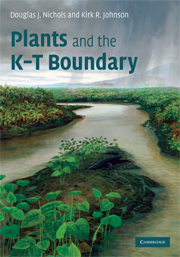6 - Williston Basin – the most complete K–T sections known
Published online by Cambridge University Press: 22 August 2009
Summary
Overview
The uppermost Maastrichtian and lowermost Paleocene rocks in the Williston Basin of western North Dakota, northwestern South Dakota, and eastern Montana contain the best exposed and most studied nonmarine record of the terminal Cretaceous event in the world. This region contains 41 (39%) of the known terrestrial K–T boundary sections (see Table 2.1 and Appendix). The Williston Basin is a large structural depression occupying much of North Dakota and parts of South Dakota, Montana (Figure 6.1), and it extends into southern Saskatchewan. The stratigraphic units in which the K–T boundary is preserved are the Hell Creek Formation, which for the most part is Maastrichtian in age, and the Fort Union Formation, which for the most part is Paleocene in age (Figure 6.2). The Hell Creek Formation is composed of fluvial sandstone, mudstone, and claystone. It includes rare, thin lignite beds and minor marine units. It was deposited at the edge of the Western Interior seaway (Roberts and Kirschbaum 1995, Johnson et al. 2002). The Fort Union Formation is composed of extensive lignite and carbonaceous shale beds, variegated mudstone of lacustrine origin, and sandstone largely of crevasse-splay origin. The facies change that marks the formational contact was caused by rising sea level during a temporary re-advance of the Western Interior seaway in early Paleocene time known as the Cannonball Sea, a Paleocene remnant of the Cretaceous seaway represented by the Cannonball Member of the Fort Union Formation (Figure 6.2).
- Type
- Chapter
- Information
- Plants and the K-T Boundary , pp. 69 - 103Publisher: Cambridge University PressPrint publication year: 2008



